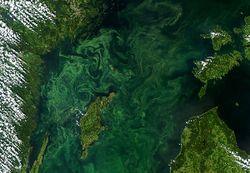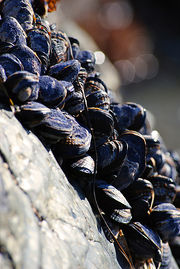Case studies eutrophication
Contents
- 1 Ecological impacts of eutrophication (Case study: Eutrophication and dead zones)
- 2 Human health impacts of eutrophication (Case study: Humans at the top of the food web)
- 3 Economic impacts of eutrophication (Case study: Shellfish flavour)
- 4 Recreational and aesthetic impacts of eutrophication (Case study: Foam on the beach)
- 5 References
Ecological impacts of eutrophication (Case study: Eutrophication and dead zones)
Introduction
Dead zones are very low oxygen areas (hypoxic) in the ocean where marine life including fish, crabs and clams cannot survive. In the 1970s oceanographers began noting increased instances of dead zones. A 2008 study counted 405 dead zones worldwide[1]. Hypoxia is a natural phenomenon that occurs periodically in coastal waters around the world. During the last 50 years however, increases in key pollutants from human activities on land have thrown many coastal ecosystems out of balance, resulting in expanded dead zone regions.
Causes and consequences
Aquatic and marine dead zones can be caused by an increase in nutrients (mainly nitrates and phosphates) in the water known as eutrophication. Major nutrient sources come from human activities such as the use of fertilizers in agriculture and the burning of fossil fuels. These nutrients lead to a rapid increase of the density of certain types of phytoplankton resulting in algal blooms. The organic matter produced by these phytoplankton species at the surface of the ocean sinks to the bottom (the benthic zone) where bacteria break it down. The bacteria use oxygen and give off carbon dioxide during this breakdown. Fish and mobile invertebrates can migrate out of hypoxic areas. Plants and animals that are slow moving or attached to the bottom (sea grass, worms and clams) cannot escape from the dangers of hypoxic waters and will die. The dead zone of the Baltic Sea is probably the largest worldwide [1]. Overfishing of Baltic cod has greatly intensified the problem. Cod eat sprats, a small, herring-like species that eat microscopic zooplankton that in turn eat the algae. So, fewer cods and an explosion of zooplankton-eating sprats means more algae and less oxygen- a vicious cycle develops [2].
Solutions
The main goal in reducing dead zones is to keep fertilizers on the land and out of coastal waters. The Black Sea dead zone largely disappeared between 1991 and 2001 after fertilizers became too costly to use following the collapse of the Sovjet Union and the demise of eastern European economies. Nutrients loads entering the sea where therefore considerably reduced. Fishing has again become a major economic activity in the region. However, our ocean ecosystems are fragile and the combined threats of climate change, overexploitation, pollution and habitat loss,all mostly caused by human activity, are undermining the sustainability. Expanded dead zones caused by global warming will remain for thousands of years and have harmful long-term effects on ocean ecosystems.
Human health impacts of eutrophication (Case study: Humans at the top of the food web)
The consumption of shellfish (e.g. mussels, clams) is one of the most common ways for algal toxins to impact human health. Marketable shellfish are generally considered to be safe, but in spite of these precautions, there are known illnesses. One dramatic incident occurred in 1990 when six fishermen almost died from eating mussels during a fishing trip on Georges Bank, a productive offshore finfish and shellfish area. The fishermen became ill after eating a pot of mussels they had caught in their nets. The Captain, who had joined the meal later than the rest of the crew, witnessed his fellow fishermen become incapacitated due to the paralytic effects of the toxin. He himself also became ill, but was capable of sending an urgent radio message to the US Coast Guard. In the hospital they were treated using respiratory therapy to sustain their breathing and prevent them from dying due to paralysis of the lungs. The event, presumably caused by a massive Alexandrium [3] bloom transported offshore from areas along the northeast coast, closed the surf clam industry on Georges Bank to further harvest. Source: WHOI [4]
Economic impacts of eutrophication (Case study: Shellfish flavour)
Some algae and diatoms impart off-flavours or bitter taints to shellfish, rendering them unpalatable and unmarketable. In 1987 in Port Phillip Bay, Melbourne, Australia, a bloom of the diatom Rhizosolenia chunii [5] [6]occurred and 3 species of shellfish within the bay, mussels, oysters and scallops, developed a powerful bitter taint. The taint was so persistent and unpleasant that the mussels from the bay were unmarketable for 7 months, causing a revenue loss of approximately $1 million.
Recreational and aesthetic impacts of eutrophication (Case study: Foam on the beach)
Some algae, particularly of the taxa Phaeocystis[7], produce a mucus, which when disturbed produce a foam. These algae are more prone to develop when there is little competition. It seems that in areas such as the south-east coast of the North sea, where all the silica has been captured by diatoms in estuarine regions, the residual nitrogen is used by Phaeocystis to bloom. They produce large amount of mucus which, if the weather is windy, will in turn be transformed into large amounts of foam covering extensive areas of beach and lake shores. Besides the impact on the landscape and the nuisance it represents for tourists, this foam is suspected of disturbing flat fish larvae development. This phenomenon is frequently observed at the Belgian and Dutch coasts, and appears from time to time in Germany.
Coastal Wiki articles on eutrophication are listed in the category Eutrophication.
References
- ↑ Diaz R. J, Rosenberg R. (2008): Spreading dead zones and consequences for marine ecosystems. Science 321, 629.
- ↑ Westman, 2010; cited in Owen 2010. World's Largest Dead Zone Suffocating Sea, National Geographic News.
- ↑ WoRMS (2012). Alexandrium Halim, 1960 emend. Balech, 1989. In: Guiry, M.D. & Guiry, G.M. (2012). AlgaeBase. World-wide electronic publication, National University of Ireland, Galway. Accessed through: World Register of Marine Species at http://www.marinespecies.org/aphia.php?p=taxdetails&id=109470
- ↑ http://www.whoi.edu/science/B/redtide/foodweb/shellwedolunch.html
- ↑ Kraberg, A. (2011). Rhizosolenia chunii Karsten, 1905. Accessed through: World Register of Marine Species at http://www.marinespecies.org/aphia.php?p=taxdetails&id=341502
- ↑ Parry, G.D., Langdon, J.S. & Huisman, J.M. (1989). Toxic effects of a bloom of the diatom Rhizosolenia chunii on shellfish in Port Phillip Bay, southeastern Australia. Marine Biology, Berlin 102: 25-41.
- ↑ Guiry, M.D. (2011). Phaeocystis. In: Guiry, M.D. & Guiry, G.M. (2011). AlgaeBase. World-wide electronic publication, National University of Ireland, Galway. Accessed through: World Register of Marine Species at http://www.marinespecies.org/aphia.php?p=taxdetails&id=115088
Please note that others may also have edited the contents of this article.
|


